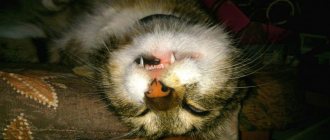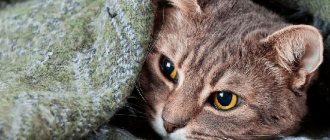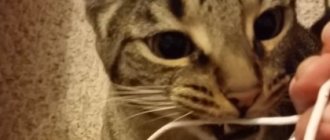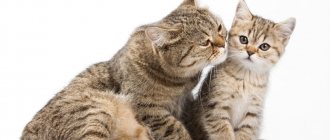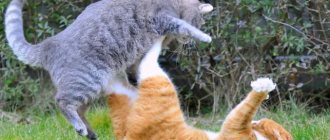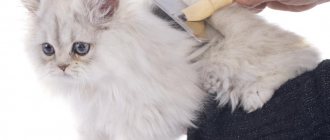Possible reasons
When a cat begins to shake its head more than usual, the owner needs to keep in mind the following reasons:
Otitis;- Entry of a foreign body into the ear canal;
- Demodectic mange;
- Allergy;
- Injuries;
- Otodectosis;
- Neoplasms.
In rare cases, severe head injuries can cause constant head shaking, but such signs cannot be confused with anything else.
A common disease that never appears on its own. Otitis is always provoked by something. Most often this is a bacterial infection, an allergic reaction or otodectosis. It can be acute or chronic. The following symptoms are characteristic of otitis media:
discharge from the ears;- unpleasant odor;
- itching;
- redness;
- peeling.
At the same time, the cat shakes its head and tears its ears until they bleed. Cleaning does not lead to anything, since the root cause must be eliminated. In decorative breeds, otitis media can be caused by food allergies, which are always aggressive in them. Only nutritional correction will help here. In common breeds, otitis may be triggered by an allergy to flea bites or saliva. Things are more complicated with otitis caused by formations in the ear canal. Due to constant contamination, it is impossible to inspect the ear canal. Otoscopy is also indicated. I would also like to draw attention to the fact that in the same cat, otitis media in one ear can be caused by a bacterial infection, and in the other by a fungal infection. That is why it is recommended to conduct a cytological examination from both ears.
Main predisposing factors
In many cases, this can happen due to various infectious and parasitic diseases, as well as their consequences. The most common reasons are the following:
- Damage to the gastric mucosa.
- Similarly - ulceration of the mucous membrane of the thin and thick sections of the gastrointestinal tract.
- Peritonitis of infectious etiology.
- Inflammation of the mucous membrane of the small gastrointestinal tract.
- Parasitic diseases.
- Pyometra or endometritis (indicated by discharge from the genitals).
- Abscesses of internal organs (especially in the liver and pancreas).
In all these cases, such a strong pain reaction develops that the intestines literally “twist” from spasms. But disease or parasites are not always to blame for a cat’s suffering. There are reasons for non-infectious etiology:
- Tumors of benign and malignant etiology.
- Poisoning.
- Birth defects.
- Abdominal trauma in which internal organs were damaged, or a strangulated hernia.
- Abnormal pregnancy. Possibly torsion of the uterus.
- Pinched nerves (due to injury, or congenital cases).
- Stones in the kidneys, bladder, urinary tract.
- Gallbladder obstruction, liver or gallstones.
- Intestinal volvulus, but for cats, is an extremely rare pathology that is more typical for dogs.
Foreign body
A foreign body entering the ear canal causes the cat to shake its head and behave restlessly. If the splinter is not removed in time, the development of purulent otitis media is inevitable. The foreign body can be thorns from a cactus, plants, or the remains of claws after a fight with relatives. When removing the splinter yourself, it is recommended to thoroughly disinfect the wound and the tools that will be used to remove the splinter. If after extraction no purulent discharge or unpleasant odor appears within 3-5 days, then we can assume that everything went well. Otherwise, it is better to immediately take your pet to the veterinarian.
Types and signs of seizures
There are several signs by which seizures are usually classified:
- non-epileptic and epileptic seizures can be based on the mechanism of development;
- according to prevalence, they distinguish between limited or local/focal, generalized and unilateral;
- Based on the time during which a group of muscle fibers contracts, they are divided into: myoclonic, tonic and clonic convulsions.
Epileptic convulsions occur under the influence of hypersynchronous discharge. As is known, the brain, or more precisely, neurons communicate through weak electrical discharges; the simultaneous discharge of a large group of neurons leads to characteristic attacks of uncontrolled muscle contractions.
Non-epileptic seizures can have a wide variety of causes, from vitamin B6 deficiency, toxin poisoning, convulsive form of fainting to endocrine disorders or organic damage to brain structures.
Myolonic seizures are short-term seizures.
Clonic - represent a frequent change in the tone of muscle fibers or their groups, in other words, twitching.
Tonic is a fairly prolonged muscle spasm.
The animal, neither during the attack nor after it, can in any way describe its condition, so the owner needs to be very attentive to his pet, and if he notices the following signs, be sure to take the cat for a consultation to the clinic, even if after the attack the animal looks healthy:
- convulsions of the whole body or convulsive twitching of the paws;
- tense, crooked legs tucked under the stomach;
- loud painful cry of an animal with cramped limbs;
- the animal falls to the floor in convulsions or moves its paws back, as if trying to stretch;
- the animal's pupils are dilated, its whiskers are pressed down;
- if the convulsions are focal, the animal is conscious, it is not given to the owner;
- involuntary urination (in severe cases);
- foaming from the mouth (also in severe cases).
With mild cramps of the limbs, sometimes the animal tries to rise, but to no avail. But more often, until the end of the attack, the cat is afraid to move, because movements can cause pain. But pain is not necessary. Sometimes convulsive attacks are not accompanied by severe discomfort, so the animal can behave calmly, despite the twitching limbs.
After the seizure ends, the animal can behave as usual, as if nothing had happened. Or he may lose orientation for a while and not find his favorite place or bowl.
Allergy
It can often manifest itself as dirty ears, itching, redness and baldness in specific areas of the body. In severe forms, the cat shakes its head and scratches its ears. You can see black discharge inside the ear canal. If there is a strong odor, then there is a possibility of a fungal or bacterial infection. This reaction is almost always provoked by incorrectly selected food and feeding the pet from the table. You also need to rule out flea dermatitis and allergies to parasites. Decorative breed cats (British, Scottish, bobtails, sphinxes, etc.) are prone to allergies. You need to understand that it will not be possible to get rid of dermatitis once and for all, so the animal will need special care throughout its life (hypoallergenic food, timely worming and flea treatment).
the cat runs around, licks its paws, tail, and tugs its skin
Get rid of fleas immediately. You have typical symptoms of infection.
Hello! I have the same problem with my cat as you. Unfortunately, I live in Dubai and one visit to the vet costs me $100. And this is without tests and medications. I have already gone to the doctor with my cat twice. Nothing was found. No fleas, no worms. Nothing. They just said that he might have asthma attacks. but again, it’s not clear why he licks the tail, the bottom of the back and the hind legs. and also hides from everyone during attacks. when he runs hard = he breathes like a dog with his mouth open. I really feel sorry for him, but most of all I’m afraid that 2 other cats may become infected. Were they able to help you? please share your experience
Sincerely, Angelika
I found the answer on another forum. This is paraproctitis. Here in Dubai, veterinarians don’t know anything at all. so you need to go to them with a diagnosis and preferably with knowledge of how to treat it, so that they just give the medicine. Ehh, at least it would be confirmed that this is really what we think> Read what I found from other cats. The picture is very similar. “yes, we had this happen, at about one year of age, he sits, twitches his fur and tail nervously, and then when he runs, we asked the vet what this could be connected with. he told us that most likely this is due to the drying out of the anal glands, which secrete secretion to facilitate bowel movements (and not only), if not enough secretion is secreted, then they itchy there, that’s why they get sore, that’s what it looks like. here is a dog in the picture, but cats have the same thing, we didn’t do anything, somehow it went away on its own “
Injuries
Domestic cats experience fewer injuries, since there are many risks on the street in the form of fights with relatives or other animals. If the injury is severe (for example, after a fall from a height), the pet may shake its head for a while and lean to one side. If this condition does not go away within 24 hours, it is recommended to immediately take him to the nearest veterinary clinic. To make a diagnosis, it will be necessary to exclude injuries to the skull, cervical spine, and concussion. Injuries can also include insect bites, after which the cat not only shakes its head, but also rushes around the house. We are talking about wasp and bee stings in the area of the nose, lips, ears and eyes. The bite site always swells and turns red. It is recommended to immediately give your pet an antihistamine (Fenistil, Cetirizine).
the cat's stomach is twitching
They did an ultrasound: nephritis, signs of hepatitis, enlarged spleen, urinary stones. Toxoplasmosis and other infections (viral leukemia, immunodeficiency) are negative. Now we feed him food for hepatitis, heptral, lactulose and now we will buy conephron. Biochemistry creatinine 166, alt 239, ast 153, alkaline 105, protein 84, bilirubin 1.5, glucose 7.3, amylase 823. male 3 years old, uncastrated, 3.5 kg. Help please. I feel sorry for the cat. 5 different veterinarians have already looked and don’t know. They say it's either flea or neutered. But we have him clean, he doesn’t walk on the street, he’s already been treated for them 3-4 times (dropped 7 times) What is this? Prescribed stop stress did not help. And the cat himself is very calm and affectionate. Since childhood, the tip of the tail has been slightly broken
nephritis, signs of hepatitis, enlarged spleen, urinary stones - not good at all. think about whether the cat comes into contact with any chemicals at home. whether you brought new furniture into the apartment, laid laminate floors, etc. simply poisoning with phenol vapors and other compounds can cause a similar picture. Some flea drops, by the way, also hit the liver so hard that it can even be fatal. I had this in practice - in a pet store they sold people anti-flea drops, in the ampoule, apparently, the concentration was for a dog, and the sticker was put on for a cat. In general, I saved one cat, but the second was not even brought to the clinic. the second option is a viral infection. but this is almost always a high temperature at the beginning of the disease. the third option is bad food. put the cat on a starvation diet for 3 days. Give only the best filtered water, always soft and free of hardness salts. plus freshly squeezed carrot juice 5 ml 2 times a day to dissolve salts in the kidneys and no food (store-bought juices are not suitable, only freshly grated carrots and the juice that has drained from it are good. You need to force the juice into the cat from a syringe. What can you do?
Source
Neoplasms
Often found in individuals after 5 years of age. They have benign (polyps, papillomas) and malignant
nature (sarcoma, lymphoma, carcinoma, melanoma). Almost always, all neoplasms provoke the development of otitis media and discharge from one (affected) ear. In advanced cases, the cat shakes its head and leans to the side. For single polyps of small size, you can limit yourself to observation and in the absence of growth and inflammation, you can leave it alone. If the polyp increases in size or provokes otitis media, then its removal is necessary. The prognosis is favorable in most cases. Everything is more complicated with malignant tumors, due to which blood and pus can be released from the ears. There is a foul odor. To confirm the diagnosis and determine the stage of the tumor, otoscopy, MRI of the head and radiography are performed. In the absence of metastases, surgical excision of the formation is performed, including healthy tissue (in 70% of cases, the entire ear canal is removed). And even if the operation is successful, the prognosis is cautious, since malignant tumors in the ears are prone to recurrence.
In conclusion, I would like to remind you about otodectosis, in which a cat can also shake its head and ears. Here again, everything can be complicated by bacterial or fungal otitis media. To exclude and prevent ear mites, it is recommended to regularly treat your pet with medications (Stronghold, Frontline, Advocate).
Causes of head tremors
A healthy cat can move its head from side to side before jumping. At the same time, he can bend down to the ground and twist his croup, or he may not do this. Carefully and concentratedly following the object of interest with its eyes, the cat can make twitching movements of its head from side to side with a small amplitude.
During sexual arousal, animals may experience slight tremors. The cat can make small movements with its head. The trembling usually spreads throughout the entire body.
Why does the cat shake its tail?
The tail of cats serves primarily as an indicator of mood. By moving it, they express:
- Anxiety. By wagging its tail and pressing its ears to its head, the pet shows that something is bothering it.
- Willingness to engage in combat with a possible enemy or pursue a victim.
- Doubt.
- Pleasure. Cats wag the tip of their tail when they are happy and try to show their owners the depth of their overwhelming feelings.
- Curiosity. When a pet explores something with interest, its tail twitches.
- Irritation. If an animal actively swings its tail from side to side, it means it is irritated.
Symptomatic treatment
Physiological tremor does not require treatment.
To understand that a cat is shaking its head because it is in pain, it is important to observe it. The following signs should alert you:
- the animal not only shakes its head, but also actively itches (to the point of wounds and abrasions);
- pus or ichor flows from the ears;
- the cat does not lay its head on a certain side;
- the animal's appetite decreases or completely disappears;
- there is a shaky gait, movements are not coordinated;
- the cat meows loudly and pitifully or, on the contrary, becomes lethargic and tries to hide from prying eyes.
In case of pathological jerking of the head, the diagnosis must be made by a doctor. To do this, he will examine the cat's ears and take blood tests. If no external signs of pathology are found, the veterinarian will perform an ultrasound or computed tomography. After making the correct diagnosis, the specialist will prescribe the appropriate treatment:
- For the treatment of otodectosis, antiparasitic ear drops may be sufficient; for the treatment of otitis, antibiotics will have to be used.
- It is also best to entrust the removal of foreign bodies from the ear to a veterinarian. After the procedure, the specialist will treat the ear with antibiotics and prescribe drops that will help avoid infection.
- Antifungal therapy involves treatment with chlorhexedine (rinsing the ears with a solution) and treating the ears with Otibiovin drops. Veterinarians also prescribe internal administration of Ketokenozol. But it must be given to your pet strictly in the dosage recommended by the veterinarian.
- Dermatitis is treated with hydrogen peroxide and treatment with ointments that have astringent properties, for example, 2 percent silver nitrate. Dropping a few drops of novocaine into the ears will help relieve itching.
- If neoplasms occur, the issue of surgery is decided. Most often, the ear and hearing can be preserved when growths and tumors are removed.
- Neurological disorders and failure of one or another organ require specific treatment, which can only be offered by an experienced veterinarian.
- Multiple organ diseases and liver failure require treatment of the underlying disease. When recovery occurs, the tremor will go away.
Causes of bloating in adult cats
If your cat has a swollen belly and sides, possible causes may include:
- disturbances of intestinal microflora;
- inflammation;
- swelling;
- internal bleeding;
- tumors;
- parasites.
Bloating in a cat does not bode well.
Important! Only a doctor can make an accurate diagnosis after taking blood, urine and stool tests. If necessary, an ultrasound is performed.
Accumulations of air and gas
Aerophagy is the swallowing of air during food consumption. If your pet eats food particularly greedily, air gets in, forming bubbles inside.
Another common cause is excess gas production in the intestines. Most often it is associated with an incorrect or unbalanced diet. Foods that can cause bloating:
- fat and other meat waste;
- bread;
- milk;
- dairy products;
- feed with high soy content;
- wheat;
- corn.
The first three products are prohibited from being given to kittens and adult cats. Most dairy products cause flatulence in a kitten. The consumption of the rest should be halved. The accumulation of gases is caused by any spoiled food. Within the normal range, increased gas formation continues for 1-2 hours after eating, and then goes away.
Symptomatic diet and procedures
It is worth remembering that a cat will not just shake its head for a long time or scratch the ear area until it gets abrased. Most often, the cause of tremor, fortunately, is not associated with serious disorders, and recovery occurs quickly.
But many diseases, in particular the appearance of ear mites, fleas, injuries, foreign bodies and water getting into the ears, can be prevented. It is enough to monitor the cleanliness of your pet’s body in general and the ears in particular. At the first signs of parasites, it is important to treat the ears with medications as quickly as possible.
If the cat is domestic, you should not let it go outside alone. And after “rolling on the ground,” the cat’s ears need to be carefully cleaned. Do not use a cotton swab on your ears. For cleaning, use soft cotton swabs rolled into tubes. The tampon must be damp. Before treating your ears, you can dip it in boiled water or saline solution.
Causes
Having good flexibility, cats have a perfect muscular system that is not prone to spasms and cramps. They easily control the work of each muscle group. Therefore, the appearance of convulsive conditions most often indicates pathology and requires contacting a veterinary service.
Spasms as a normal reaction of the body
Seizures in a cat that occur during sleep are a normal reaction of the body. Sometimes you can notice how a kitten that is sleeping has its hind legs, ears, and eyelids twitching. This reaction occurs when the animal has vivid dreams. Scientists conducted a series of neurophysiological studies, during which they found that cats, after a day full of impressions, dream of hunting, exploring the area, and communicating with their fellow tribesmen. This state during sleep does not pose a danger to the animal’s health and disappears without a trace after waking up.
Spasms as a pathological reaction
Diseases of which spasms are a symptom can be divided into several groups. All of them represent the reasons for the appearance of this violation:
- neurological diseases occurring with brain damage;
- consequences of metabolic disorders;
- disruption of brain activity as a result of the action of toxic substances;
- other conditions and pathologies.
Neurological diseases with brain damage
There are a lot of diseases of the nervous system that cause complications in the brain. These are infectious or organ-specific pathologies. Their neurological manifestations are approximately the same, although the nature of the seizures may differ. In order to understand what their causes are, a high-quality diagnosis is necessary.
Tick-borne encephalitis
This is a viral infection transmitted by ixodid ticks. All animals are susceptible to disease, regardless of whether they go outside. If an embedded tick is found, it must be removed immediately. But if infection has already occurred, the first symptoms will soon appear: low-grade fever, refusal to eat, intoxication. Later, neurological disorders appear: paralysis, convulsions during sleep and while awake, numbness.
An acute condition is life-threatening for the animal, especially if it has a weak immune system. Symptomatic treatment is used aimed at restoring the immune system. Rest and long sleep are required. This will help the body's defenses cope with the virus. If this does not happen, a transition to the chronic stage or the development of complications is possible.
Hypoxia
The main factors of hypoxia or oxygen starvation of tissues are acute cardiovascular and respiratory failure. It is characterized by many diseases of the cardiovascular and respiratory systems. Main signs: shortness of breath, pallor and cyanosis of the mucous membranes. The progression of the pathology provokes involvement of the brain, and hence the appearance of neurological signs - seizures, paresis. The stage of excitement is replaced by the stage of depression. Without help, the animal may die. Resuscitation measures are needed to alleviate the condition. The disease then needs to be treated according to its cause.
Tumors
Benign or malignant brain tumors are a fairly common cause of seizures. As the tumor grows, pressing on surrounding tissue, neurological symptoms also continue to increase. Along with a convulsive attack, loss of consciousness, convulsions, walking in a circle, and behavioral reactions may be observed. The cat needs to be seen by a doctor as soon as possible, since how quickly the diagnosis is made and surgery is scheduled determines how long the animal will live and what its quality of life will be.
Head injuries
The main causes of head injuries are falls from a height, dog bites, injuries in road accidents, being hit by doors, and others. The first symptoms of injury are bleeding from the nose and ears, loss of consciousness, and loss of coordination. Quite often, seizures can occur as a reaction of the body to brain damage. Therapy is used in accordance with the severity of the animal's condition. Oxygen therapy is used by placing animals in an oxygen chamber and artificial ventilation. It is extremely important for the animal to be at rest during the treatment period.
Epileptic seizures
This disease is rare in cats. In most cases, it is congenital (genetic pathologies). The disease is expressed in the appearance of convulsive seizures, which occur suddenly and last for some time. In cats, seizures due to epilepsy are often generalized. The disease itself does not pose a threat to the life of the animal. Most often, cats suffer from injuries. Therefore, the owner is required to do everything to prevent this from happening.
The animal must be shown to an experienced veterinarian. It is important for the doctor to find the cause of the disease, since in this case the disease can be completely cured. If a cat is diagnosed with “idiopathic epilepsy,” it will be treated for life with antiepileptic drugs that alleviate the animal’s condition.
Consequences of metabolic disorders
Metabolic pathologies that cause cramps and muscle spasms include the following diseases.
Avitaminosis
Avitaminosis (vitamin B1 deficiency) causes a dangerous disorder - metabolic encephalopathy. In the absence of thiamine, the brain stem is affected. The reason is the constant presence of raw fish in the diet. Thiaminase contained in it prevents the entry of vitamin B1 into the body. The main symptoms are loss of coordination of movements, tremors of the limbs, convulsions. Starting in the hind legs, the spasms also spread to other muscles, gradually involving the entire body.
Hypoglycemia
A sharp drop in blood sugar in a cat with diabetes causes loss of consciousness and convulsions. The condition is relieved by administering glucose through a dropper, by injection or orally.
Poisoning
When toxic substances are swallowed or inhaled, or household chemicals enter the body, toxic substances affect the nervous system through the blood. Severe helminthiasis also leads to poisoning. The main way to eliminate this situation is to detoxify the body. The animal is provided with rest, the stomach is washed, and, if necessary, the blood is purified.
Other conditions and pathologies
Death throes
Seizures usually occur in cats before death. Agony (near-death state) is accompanied by acute hypoxia, which indicates a decrease in heart rate and respiration. Muscles suffer from lack of oxygen. At this point, the cat may experience severe pain. In such cases, the most humane decision is often to euthanize the animal.
Other reasons
Intolerance to anesthetics administered to kittens during various medical operations and manipulations can manifest as symptoms of allergic reactions, cardiovascular disorders, hypoxia and convulsions.
Seizures may occur after sterilization or after childbirth. These processes are a strong stress for the body. Castration, in addition, causes severe hormonal disruption.
Kidney pathologies are difficult to treat and are prone to relapse. In case of kidney failure, the body is poisoned by waste products. As a result, autoimmune reactions and inflammation appear. Later, symptoms of damage to the central nervous system appear.
The cat's head is twitching - is this a reason to contact a specialist?
Owners of four-legged pets sometimes notice characteristic head twitching. Pets can make such movements absolutely naturally and consciously. In some cases, small movements are involuntary and indicate a pathological condition of the animal that requires attention and treatment.
When a cat's head twitches, it may just be getting ready to jump. Such movements are typical for a furry pet before concentration and sudden action. At the same time, you can notice that the cat presses itself to the ground and begins to twist its croup (it may not twist), the animal’s eyes rotate with concentration following the object of interest to it, and its head makes small movements similar to shaking. Head shaking during sexual arousal is not a deviation either. The cats begin to jerk their heads slightly, and then the shaking is transmitted throughout the body. But if the animal does not have the above signs, then tremor may indicate developing pathologies.
The cat's tail and skin on its back twitch - why and what does this mean?
Cat owners sometimes observe the following picture: the pet's tail twitches, as if he is marking territory, and the skin on his back shakes, as if he is trembling in this particular part of the body. This phenomenon may have physiological and pathological causes. Regardless of what exactly led to the twitching of the tail and skin, the four-legged pet in this situation requires the help of the owner.
If an adult cat or kitten twitches its tail, while the skin on its back trembles, it may be overcome by ectoparasites (those that parasitize not under the skin, but on its surface): fleas, lice eaters, ticks. In addition to these symptoms, external parasites manifest themselves as follows:
- bite marks on the body in the form of small red dots;
- unbearable itching in the affected areas;
- constant scratching in an attempt to somehow relieve the itching from the bites;
- jumping black dots, grains that look like dirt;
- deterioration of the coat (loss, loss of shine, fragility);
- sleep disturbance – due to constant itching, the cat hardly sleeps;
- complete or partial lack of appetite;
- anxiety, lack of interest in games, apathy;
- ulceration of the affected skin, scabs;
- reduction in body weight.
Is your pet shaking its tail? This may be a sign of anxiety. Don't confuse anxiety with stress. Both of these conditions are associated with negative emotions, but in the first case they are not as pronounced as in the second. Anything can cause anxiety in a cat. She may get nervous because of a large crowd of people in the house, the appearance of a stranger in it, the long absence of the owner, etc.
In order for the pet to calm down, you need to pick it up, caress it, and talk to it. It is best to try to switch the animal's attention to something else, such as a game. By spending time actively and having fun, it will forget about worries.
If an animal's back twitches closer to its tail, it most likely wants to go to the toilet. Observing cats, you can notice that their skin in this area begins to tremble before bowel movement occurs. This is normal.
This situation requires the intervention of the owner if the trembling does not end with defecation, and the pet becomes restless, meows pitifully, and refuses to eat. This behavior indicates constipation. If your four-legged pet does not defecate for several days in a row, it is time to take measures to empty its intestines of feces.
Is your pet twitching its tail, the skin on its back shaking, while it is worried about something or meowing pitifully? Perhaps he was bitten in this place by a wasp, bee, mosquito or horsefly. To help your pet cope with itching and pain, you must first make sure that there is no insect sting left at the site of the bite. If it is detected, you need to carefully remove the foreign body with disinfected tweezers.
Wasp and bee stings are not as harmless as they might seem at first glance. Its danger is that the cat may develop an allergic reaction to bee and wasp saliva. If you discover that your cat has been bitten by an insect, you need to give him an antihistamine and carefully monitor his condition. If suspicious symptoms appear, the pet should be taken to the nearest veterinary hospital as quickly as possible. To eliminate pain and itching, you need to anoint the bite site with antipruritic ointment.
This problem may be caused by an allergic reaction. Allergies in cats can be caused by pollen from flowering plants, dust, the owner's perfume, food, medications, substances secreted by ectoparasites, litter for the litter box, etc. The increased sensitivity of the cat's body to allergens is manifested by a number of symptoms common to all irritants:
- skin rashes;
- deterioration of hair condition (loss, fragility);
- unbearable itching;
- bloody wounds due to scratching;
- nasal congestion;
- copious clear nasal discharge;
- sneeze;
- excessive salivation;
- peeling of the paws, especially in the areas between the toes;
- breathing problems;
- indigestion.
Pathological causes of head tremors in cats
If a cat's head twitches, then special attention should be paid to the health of the cat. In some cases, a veterinarian diagnoses serious illnesses. Common cat diseases include:
- Otodectosis. This cat disease is popularly called ear scabies. The animal develops parasites in the ear cavity. At the same time, the pet begins to actively shake its head and furiously scratch its ears with its paw. The causative agent is a small mite that bites into the tissue of the shell. The cat experiences severe itching, and while scratching it makes a plaintive meow. Upon careful examination of the ear cavity, the owner can identify abrasions and scratches. In the depths, black and brown discharge is recorded, consisting of dried blood and waste products of parasites. Banal cleaning of the ear canal does not have a positive result. The pet continues to experience extreme discomfort from otodectosis;
- Sulfur plug. The accumulation of wax forms plugs in the ear canal. The cat's hearing decreases and he begins to shake his head strangely, trying to remove the foreign particle;
- Otitis media. This is an inflammatory disease. The ears begin to hurt very much and fester. If your cat's head is trembling, and the animal does not allow you to examine the sore spot, then it may be a cold. The owners note a purulent odor from the ears and the discharge of a purulent mass. It is necessary to take your pet to a veterinarian;
- Diseases of a neurological nature. Tremor can be observed with encephalitis, stroke, dizziness, and head injury. In this case, you need to carefully monitor the pet’s behavior and its general condition. If accompanying symptoms are recorded, such as unsteadiness while walking, movements in a circle, pupils of different sizes, diagnostics in the clinic is required;
- Liver, kidney or multiple organ failure. The condition clearly indicates a failure in the normal functioning of the organ. This disease is very difficult for pets to tolerate. In this state, the cat jerks its head strangely. The pathology leads to the death of the four-legged friend. Tremor occurs in most cases in the last stages, before which the animal feels unwell and its former activity disappears. At the first sign, you need to take your pet to the veterinary clinic.
the cat has a lump on her stomach
everyone thought that she wanted a cat, but usually she either raises her butt or runs her paw across her face, but here she doesn’t, she behaves as usual
Actually it looks like a hernia. But I need to go to the vet, my nose tells me that it shouldn’t be particularly scary, judging by the consistency. But no one can say better than Veta!!
A castrated cat is a full-fledged cat in every sense, except: he doesn’t yell, doesn’t leave smelly marks, doesn’t run away on a spree, doesn’t come tattered and wounded, he won’t give rise to kittens that no one wants!
Actually it looks like a hernia. But I need to go to the vet, my nose tells me that it shouldn’t be particularly scary, judging by the consistency. But no one can say better than Veta!!
you know...I went to the pet store today. I told the saleswoman, she also said that it was possible that there was a hernia, but did not advise going to the doctor
Characteristic symptoms
Depending on the type of disease, various signs are present. Characteristic symptoms may be observed:
- pus in the ear canals;
- active scratching of ears with paws;
- tremor;
- lethargy of the animal;
- refusal to eat;
- unsteady gait;
- general malaise.
To make a correct diagnosis and prescribe effective treatment, it is recommended to promptly examine your pet by professional veterinarians. Proper treatment will avoid severe complications and death.
Treatment methods
Head tremors of a physiological nature, for example, before preparing to jump or during sexual activity of an animal, do not require treatment. In case of pathological processes, a mandatory examination in the clinic, examination, and hardware diagnostics are required. Antiparasitic drops in the ears are prescribed as a treatment for otodectosis. In the case of otitis media, it is necessary to include a group of antibiotics. Diseases of a neurological nature or failure of internal organs require specific treatment. In this case, only an experienced veterinarian can prescribe a complex of drugs.
Lovers of fluffy kittens need to constantly monitor the health of their pet, promptly bring it to the clinic for diagnostics, and undergo preventive examinations and vaccinations. A responsible attitude will help prevent illness and make your four-legged friend happy and active.
Why does a cat shake its head?
A healthy domestic cat can scratch its ears several times a day, but if the animal begins to shake its head, this directly indicates the development of pathological conditions in the pet. Having noticed that the cat is shaking its head, an attentive owner should definitely seek help from a veterinarian.
Head tremors in cats can be associated with the desire to jump to great heights, sexual arousal, neurological diseases, damage to the vestibular system, or diseases affecting the ears.
A qualified doctor will help you understand the reasons and will be able to prescribe the correct treatment, which will ultimately protect your pet from serious complications.
Videos and Illustrations
Children of Fauna. Otodectosis. Ear mites in cats.
If a cat shakes its head more than 2-3 times during the day, then you should take a closer look at it, as this symptom may be associated with the development of diseases that are fungal or infectious in nature. In adults, such a symptom may indicate problems with the central nervous system or tumor processes in the head and ears. Particular attention is paid to accompanying symptoms, in which the animal may fall, scratch and press its ears, sneeze, and lick its lips.
Causes
Having noticed that the cat is shaking its head, you must first examine the ear canal for the presence of parasites in the ear. Involuntary head twitching is one of the signs of otodectosis (ear mites). In some sources, the disease is listed as ear scabies.
The disease is provoked by a microorganism - a mite that inhabits the ear canal. The parasite feeds on lymph, blood and particles of epidermis in the animal’s ears. The vital activity of ear mites leads to the fact that the cat often scratches its ears and shakes its head.
Diagnosis
By the way, how can you tell if your cat has abdominal cramps? Unfortunately, there are enough external signs of this: the animal may “scream” in a voice that is not its own, lie writhing in pain, and in milder cases, vomiting is observed. Severe profuse diarrhea cannot be ruled out. If something like this is observed when you try to go to the tray “in a small way,” then you are probably dealing with kidney spasms. In the case when the same is observed when attempting to defecate, the matter is quite serious. When, during pushing, no feces are released at all, cramps can be caused by intestinal obstruction.
Diagnostics
Only a qualified veterinarian can determine the exact reason why a cat’s ears itch and it shakes its head, based on laboratory and clinical studies. It is extremely important to contact a veterinary clinic at the first signs of your pet’s ill health.
Most often, cats are diagnosed with otitis media caused by bacterial or fungal microflora. To make an accurate diagnosis, the following studies are used:
- general blood analysis;
- clinical examination;
- scraping from the affected area;
- biopsy;
- microscopic examination of smears taken.
If an ear mite disease is suspected, the animal must undergo an analysis of the contents taken from the ear. It is worth paying attention to the fact that with otodectosis, accompanied by bacterial or fungal otitis, diagnosis is difficult, since living mites die during inflammation of the ears due to the acidic environment.
Why does the animal run and nervously lick itself?
Licking is normal for cats. These clean animals are so sensitive to the cleanliness of their fur that they lick themselves at every opportunity: after eating, going to the toilet, or being touched by their owners. Moreover, by licking their fur coat, they calm down. Licking can be talked about as a normal phenomenon only when it is not fanatical in nature. Why does a kitten or adult cat run around the house and lick nervously?
The cat is stressed
These animals have a very vulnerable psyche. It doesn’t take much for a pet to lose its peace of mind. This can happen due to a trip in a car, a visit to the veterinarian, quarrels in the family, the appearance of a new four-legged inhabitant in the house, moving to another room, changing place of residence, etc. All cats experience stress differently. Some begin to run aimlessly around the apartment and fanatically lick the fur. Sometimes they do this so violently that in some areas of their bodies they become completely bald.

